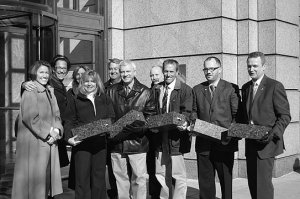Members Drive Flight Attendant Organizing at Delta

Flight attendants at Delta Airlines are pushing to join the ranks of unionized cabin crews. With almost all major airlines organized for decades, only Atlanta-based Delta has held out. Now a growing number of flight attendants there—aided by a huge team of Association of Flight Attendants (AFA) member-organizers from other airlines—have decided their time has come.
Because of the likely merger with Northwest, one of the hottest issues is seniority. In airlines, seniority has an effect far beyond wages and vacations, even more than in most industries. It determines whether a flight attendant flies once a day with a 28-hour layover in Rome or six flights per day that pay half as many hours, with a nine-hour layover somewhere less pleasant.
Delta flight attendant Toni Weinfurtner in San Diego says, “We need a voice more so than at any other time, to be able to negotiate for our own future and to have a say in how a merger or a layoff might affect us.”
Flight attendants remember that when American Airlines bought TWA, the American unions stapled the TWA employees to the bottom of the list. AFA has a constitutional provision that when two AFA units merge, seniority lists are merged by date-of-hire. Many long-timers at Delta who opposed the AFA in its last campaign seven years ago are now supporting the union.
MEMBER-ORGANIZERS
Lead organizer and Northwest flight attendant Danny Campbell coordinates a group of member-organizers from United, U.S. Airways, and Northwest.

SUPPORT LABOR NOTES
BECOME A MONTHLY DONOR
Give $10 a month or more and get our "Fight the Boss, Build the Union" T-shirt.
“The Delta flight attendants’ campaign is founded upon the mobilization model,” he said. “All campaign communications, strategies, tactics, and education are conducted by Delta flight attendants. Assistance primarily comes in the form of mentoring from experienced flight attendant organizers from other AFA carriers.”
Veda Shook, AFA International vice president and Alaska Airlines flight attendant, ran on a platform in 2006 that included the need to strengthen both internal and external organizing, to “erase the imaginary line between work done on behalf of members at the International level and work done by members and leaders in the field.”
“Crew union density has dropped from roughly 85 percent at its height to around 60 percent because of the changing aviation landscape since deregulation,” Shook said. “We have to organize the flight attendants at Delta and the other non-union carriers not only because the employees at those airlines deserve better, but because companies without represented workforces undermine our strength at the bargaining table where we do have representation.”
Salt Lake City-based Paul Tanner points proudly to his co-workers’ involvement: “I have seen a campaign grow from a small meeting among flight attendants into a nationally supported movement of over 1,200 activists.”
Activists cite many reasons why their campaign is catching on, in addition to seniority. Boston-based Tracy Kali points to the concessions since 9/11: “My fellow flight attendants are struggling and simply not making ends meet, while management flourishes.”
Voting runs from April 23 through May 28, supervised by the National Mediation Board, the agency that oversees labor relations for the airline and rail industries.





